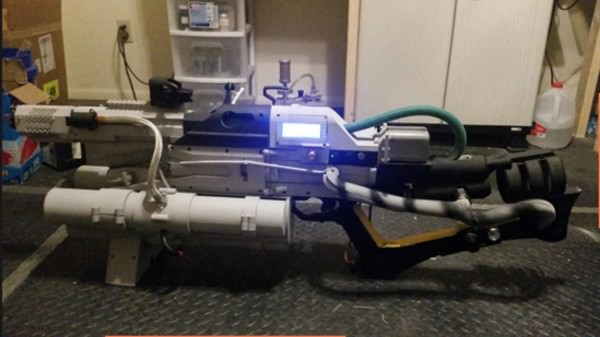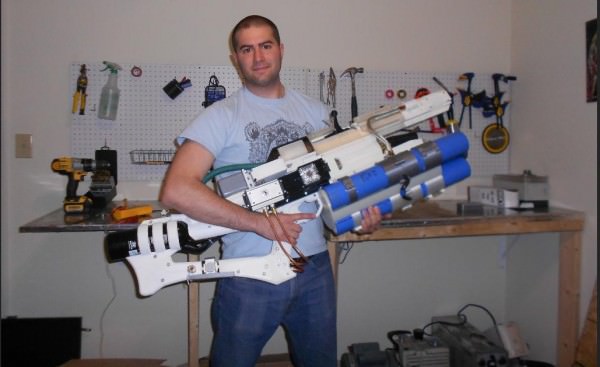
Arizona -(Ammoland.com)- A homebuilt, portable railgun is claimed to have achieved projectile energies comparable to commonly available air rifles.
In the picture above, the capacitors, which store the railgun electrical energy, have been painted white. They are the large cylindrical objects at the front and bottom of the gun.
Below is a video of a test of the railgun. The rail gun can be carried, contains its own power supply for a single shot, and expels a projectile fast enough to make a half inch dent in plywood.
It probably would have penetrated the plywood, if the plywood had not had a steel backing.
The original post only says that the velocity was over 250 meters per second. That translates to 820 fps, or 560 miles per hour. A poster on freerepublic noted a critical, and missing bit of information. From freerepublic.com:
“How heavy was the projectile? An arrow traveling at 800 fps is a formidable projectile, for instance. Mass matters.”
I was able to find the mass of the projectile with some Internet research.
WXPR Test 3 – 1″ long 0.25″ aluminum sabot (1.1g total mass). 1.6kJ caps, 500 psi injector. 36″ distance to target: angled 3/4″ plywood board with 1/4″ mild steel backplate. Made a 1/2″ deep indent in target and bounced off. Speed was above 250m/s.
The projectile mass was 1.1 grams, about 16.97 grains, so the total energy would be about 25 foot pounds. That is about the same as the most powerful common air rifles, for the minimum velocity listed.
A powerful .22 caliber air rifle such as a Benjamin Discovery or Marauder fires a 14.3 grain pellet with a muzzle velocity of approximately 900 ft/sec. The firearm generates a muzzle energy of approximately 130 ft lbs of energy at the muzzle whereas that of the air rifle is only about 26 ft lbs.
Given the 500 psi injector, and not knowing the exact mechanics of this particular rail gun, one has to wonder how much of the energy came from the injector instead of the capacitors. Note: the projectiles are the armatures in this design. Here is the answer from the posted Imgur images:
The injector system accelerates the armatures from rest in the breach loader to 100 m/s before contacting the rails.
That is about 4.1 foot pounds of energy from the injector velocity before any electrical energy is applied. If we assume 25 foot pounds of energy total, that would be over 16 percent of the energy from the injectors. Not negligible, but not overwhelming, either.
Picture of copper plated tungsten projectiles.
The railgun is capable of firing copper plated tungsten, aluminum, carbon and teflon/plasma. Here we have copper plated tungsten armatures.

The capacitors for the rail gun weigh 20 pounds, and comprise most of the mass of the design. Looking at the overall system, the assembled gun probably weighs 30 to 40 pounds.
The railgun uses 6 300J, 350V, 5500uF capacitors which combined weigh 20lbs and can deliver >1050V and 1.8kJ of energy to the projectile.

At this point, the rail gun, though portable, is far less of an effective weapon than an air rifle, not to mention a .22 rimfire. It is still an impressive achievement for a home built piece of engineering.
I used to think that an electrically propelled projectile weapon was feasible, and should be fairly easily built. Then I started looking into it. It turns out to be much, much harder than I thought. The capacitors for this rail gun hold 1.8 kilojoules. It delivers (not counting the energy contributed by the CO2 pressurized injector) 21 foot pounds of energy to the projectile, or 28.5 Joules. That is an efficiency of close to 1.6 percent. There is potential for a lot of improvement.
One poster on the Internet claimed that experimental military railguns have achieved about 10% efficiency. If this type of railgun could increase its efficiency to 10%, that would give the projectile an energy of 136 foot pounds, with a velocity of about 1900 fps. If that could be done, the inventor would need to find a way to achieve some accuracy with the assembly. That achievement has eluded military researchers so far, the last that I heard. We are a long way from even rimfire levels of performance.
It becomes obvious why traditional firearms are likely to stay around and be the weapon of choice for quite a while.
About Dean Weingarten;
Dean Weingarten has been a peace officer, a military officer, was on the University of Wisconsin Pistol Team for four years, and was first certified to teach firearms safety in 1973. He taught the Arizona concealed carry course for fifteen years until the goal of constitutional carry was attained. He has degrees in meteorology and mining engineering, and recently retired from the Department of Defense after a 30 year career in Army Research, Development, Testing, and Evaluation.

Why not dump the energy into a laser head? You’d get much better results with that kind of energy, with a much cleaner, and lighter build!
Well…the Wright brothers, a couple of bicycle-builders/sellers and back-shop experimenters in Dayton, OH., started with hand-launched gliders, and about 6 – 8 years later did the first man-carrying powered heavier-than-air, controllable flights (catapult-assisted takeoff, but still…) – which is about where this home-built railgun guy is on the development spectrum, relatively speaking. That first series of flights at Kittyhawk, NC. was ca. 1903…in 1914, air-ro-air combat began over Germany and France…so – where do you suppose railguns will be eleven years from now? It was also only about another 55 years from that first use of aircraft as aerial weaponry… Read more »
Still has a way to go.